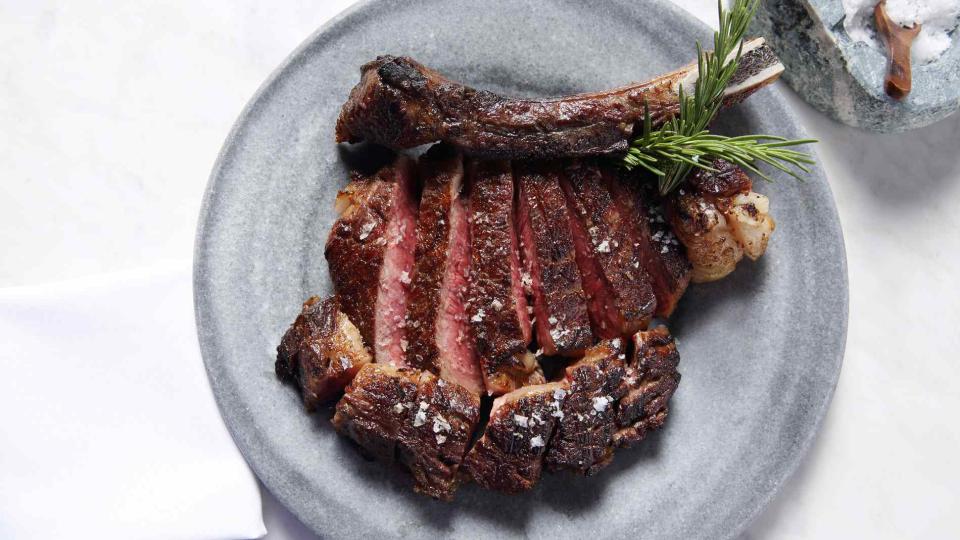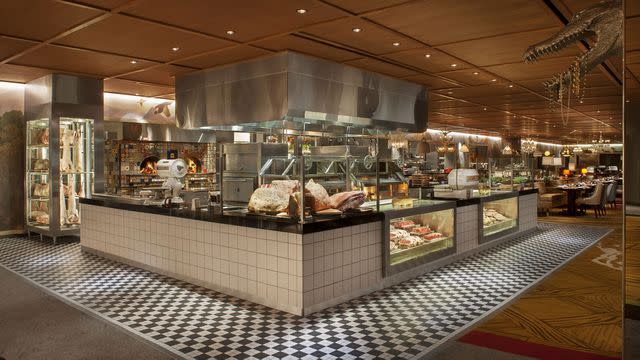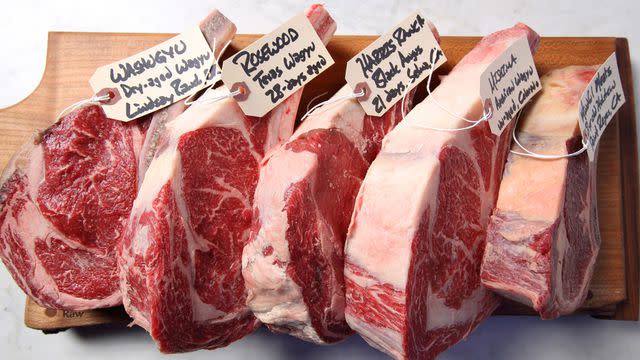José Andrés Has a Better Way for You to Grill Steak
- Oops!Something went wrong.Please try again later.
The grill-loving chef offers tips that will “change the whole game of steak.”

The most over-the-top open-fire cooking setup in the United States might be at chef José Andrés’ Bazaar Meat at Sahara Las Vegas.
The centerpiece of the restaurant is the “fire stage:” a massive display of meat and two grills, one for smaller cuts and the other for large-format beauties like colossal rib eyes. Beyond those two grills, there are two Josper combination oven-grills from Spain that can heat up to 800°F. Bazaar Meat keeps one Josper, used for vegetables, at roughly 600°F, while setting the other at a lower temperature for proteins like chicken, lobster, and octopus.
“There are places in Spain that have one Josper oven, and it’s the only piece of equipment they have for their entire restaurant,” says David Thomas, who was the opening executive chef for Bazaar Meat and is now concept chef-partner of the entire Bazaar brand. “The inside of the door gets so hot that you can use it like a plancha. It’s unbelievable.”
:

Bazaar Meat also has oak-burning dome ovens that are used only to cook suckling pigs from Spain.
The second most over-the-top open-fire cooking setup in the United States might be at Andrés’ home in the Washington, D.C. area.
“José’s got the best barbecue setup in the history of backyard barbecues,” Thomas says. “I’ve got this little Weber grill, and he’s really got all of the best equipment. That’s where we did most of the R&D for Bazaar Meat.”
When Andrés FaceTimes me from his home, it becomes clear that Thomas wasn’t exaggerating. He shows me a barbecue pit from Texas Pit Crafters, a gift from Seth Hurwitz, the huge barbecue enthusiast who runs the district's 9:30 Club music venue.
:
Then Andrés walks over to his two Josper oven-grills, which he can fuel with charcoal and “cook a chicken in nine minutes with the crispiest skin in history.” He’s experimented with grapevines and orange wood to power the Jospers, too.
The chef also has a Grillworks grill from Michigan. Then there’s a Wood Stone oven. “People use it for pizzas,” Andrés says. “I use it for baby pigs and baby lamb.”
While most of us won’t ever be able to cook as well as Andrés or grill on that level of equipment, Andrés’ methods at Bazaar Meat and at home are, in fact, replicable in your own backyard. Even if you’re using a little Weber grill for your Memorial Day party, here are some tips, including a way to prepare steak that might blow your mind.
:
Temper your meat
“Tempering changes the whole game of steak,” Andrés says.
He isn’t just referring to taking your meat out of the refrigerator and letting it sit at room temperature. At Bazaar Meat, steaks start on a rack about three feet above the coals in the grill. The indirect heat slowly brings the meat to a higher temperature. Once the steak is around 105°F — a little below rare — it’s grilled. Then you just slice and eat. There’s no need to rest the meat.
“The way I do it, you cut it, and you lose almost no juices,” Andrés says. “You want the juices to be in the meat, not out of the meat.”
He understands that you might have doubts about this process, which has been used by Spanish chefs for generations.
“It’s the exact opposite of everything you’ve been told,” Thomas admits. “Usually, you grill it as quickly as possible to medium-rare and let it rest.”
:
But this slow-tempering process — which you can do on the vegetable rack that comes with many grills, or even in an oven set to a low heat — helps preserve the meat’s flavor and tenderness. Just have your meat thermometer nearby so you’re ready to stop tempering when the steak gets close to rare.
“Because it’s been tempered, the meat has essentially already been cooked; all the connective tissue is broken down,” Thomas explains. “Now we’re getting a sear on it, and it’s done.”

Once you’re done tempering at home, you can finish it above fire “as hot as you can dream,” Andrés says. And just as important, this process lets you eat rare meat without worrying about it being cold when you cut into it.
“There’s nothing worse than meat that’s cold on the inside,” Andrés says. “Tempering works unbelievably well for the people like me who like our meat rare or, at most, at the edge of medium-rare.”
:
Yes, it might take 45 minutes to temper a thick steak in a 250°F oven, Thomas says, but just factor that into your prep time, and do it while you’re simultaneously seasoning vegetables or making side dishes. Plus, you can temper your meat, set it aside, and wait a while to grill it if you’re busy with the rest of dinner. You can also temper burgers and sausages in less time, which helps prevent overcooking when you’re going for a good sear on the grill.
Use high heat for fish
Grilling a whole fish without it sticking and flaking all over the place can be difficult. Fortunately, there are a few ways to address this.
“Like always, the key to metal and protein and gelatin and skin is that you need to make sure that the grill is really hot,” Andrés says. “When things are hot, nothing ever sticks.”
Andrés and Thomas also suggest using the metal fish baskets that are designed for grilling.
“The key to those is to get them hot first before you put the fish in,” Thomas says. “Put it in the oven or the grill and rub some oil on it.”
:
Or you can make a foil pouch with holes in it as an alternative to a grill basket, Thomas suggests.
Another method is something Andrés saw at Güeyu Mar, a restaurant in Asturias, Spain. A whole fish is cut into pieces, so the flesh can be grilled directly with the skin further away from the flames. Instead of over-charred skin, you get something wondrous.
“You get a lot of gelatin,” Andrés says. “A lot of people don’t use the skin. They’re probably missing the best part.”
When you're grilling vegetables, skin is your friend
“Vegetables are a natural for the grill,” Andrés says. “Eggplants are easy. The way I like to do it is the way we do it in Catalonia. We grill the whole eggplant; the skin is a good protector for the flesh. Onions are very good if you’re patient because you can burn the entire onion outside, and inside the flesh is soft.”
:
Andrés thinks that corn is perfect for the grill, too, and that whole potatoes work well if you cover them in aluminum foil and put them atop charcoal.
Vegetables are easy, Thomas adds, because you don’t need to do much. Just buy what’s seasonal and fresh at the local market, add a little oil, salt, and pepper, and you’re ready to grill. This prep can be done, of course, when your steak is tempering.
false

